Highlights
Asthma is a respiratory condition that can be triggered by many allergens, including pollen. As pollen-producing plants spread with the changing global climate, allergies and allergic asthma are expected to worsen. These researchers developed a successful model of ragweed-induced allergic asthma. Next, they tested the allergic responses provoked by pollen from the ragweed plant grown in different conditions. They found that the environment in which a plant is grown can affect the severity of allergic responses. In future work, the researchers hope to better understand how environmental conditions produce changes in ragweed pollen that lead to the differences observed in allergic responses.
Did you know that about
90 percent
of children with asthma also have allergies? In fact,
allergic asthma
is the most common type, comprising about 60% of all asthma cases. Allergic asthma can be triggered by allergens inside the home, like dust and mold, as well as outside the home, such as pollen. As pollen-producing plants spread with the changing global climate, allergies and allergic asthma are expected to worsen. New research by Dr. Michelle Epstein and colleagues at the Medical University of Vienna in Vienna, Austria, shows that the environment in which a plant is grown can affect the severity of allergic responses.
Asthma and Allergies
Asthma
is a chronic condition that affects the lungs and respiratory system. In people with asthma, the airways can become inflamed and narrowed. This allows less air through the
bronchioles,
which results in difficulty breathing. When this happens, it is called an
asthma attack
and may require medical attention. There is no cure for asthma, but symptoms can be managed and treated.
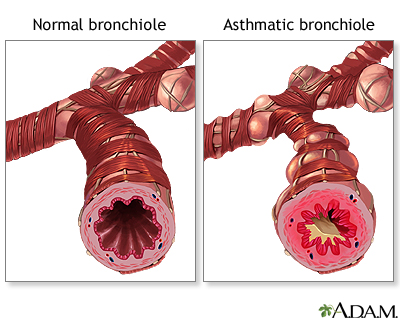
Figure 1. Narrowing and inflammation of the bronchiole during an asthma attack.
[Source: https://medlineplus.gov/ency/article/000141.htm]
There are several types of asthma that are provoked by different triggers. In most cases, asthma is considered to be allergic or non-allergic. Allergic asthma refers to asthma that is triggered by allergens, such as dust, mold, animal dander, certain foods, or pollen. Non-allergic asthma may have other triggers, like exercise, pollution, or changes in temperature.
Dr. Michelle Epstein is a Doctor of Internal Medicine and Allergy and Clinical Immunology in the Department of Dermatology, Experimental Allergy Laboratory at the Medical University of Vienna in Vienna, Austria. She has devoted her career to understanding and treating diseases of the immune system including
allergies
and allergic asthma. Her laboratory has developed several animal models to study immune and allergic diseases.
In 2007, Dr. Epstein became the coordinator for the project
Atopica
funded by the European Commission, a collaboration of eleven institutions across seven European countries. The goal of the project is to better understand the effects of environmental change on
atopic diseases
including allergies, asthma, and
eczema.
The research members chose to focus their efforts on the highly allergenic ragweed plant (Ambrosia artemisiifolia), which can cause an aggressive allergic response in humans. Ragweed is native to eastern and central U.S. and Canada, though it has now spread as an
invasive species
across the entire United States and into Europe.
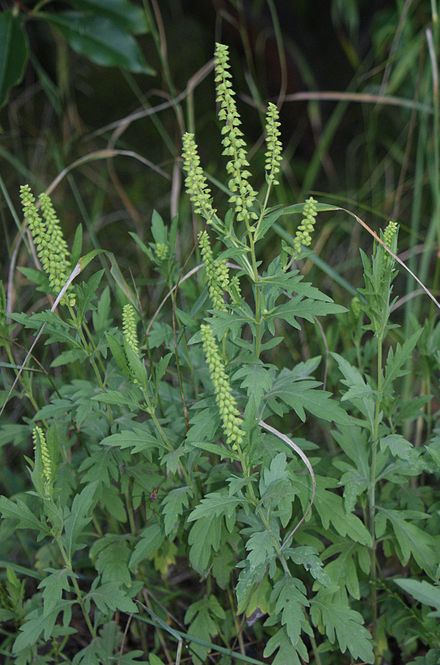
Figure 2. Ragweed plant.
[Source: https://en.wikipedia.org/wiki/Ragweed]
One study across Europe found that about 10% of Europeans experience some degree of allergic symptoms due to pollen from the ragweed plant. Ragweed is expected to continue to expand its growth range due to climate change. As a result, rates of allergies and asthma are expected to rise across Europe.
Computer models
predict the amount of ragweed in Europe will quadruple by 2050 and the number of Europeans affected by the plant will double from 33 to 77 million people by 2060.
Developing Models of Allergic Asthma
Dr. Epstein’s prior allergy research had used egg white protein as the primary allergen. Through the Atopica research project, Dr. Epstein began to study the effects of pollen on allergic responses in mouse models. Based on this mouse model, Dr. Epstein began a series of experiments to determine the proper dose of pollen needed to provoke an immune response for a mouse model of ragweed-induced allergic asthma.
The researchers began by exposing the mice to 30, 300, 3,000, and 30,000 grains of ragweed pollen for six days over the course of three weeks. Three days following the final dose of pollen, the researchers analyzed a sample of fluid from the airways and lung tissue to test for markers of inflammation. They found that 30 pollen grains were sufficient to induce an inflammatory response, and the response increased as the dosage of pollen increased. The highest dose of 30,000 grains induced severe inflammation of the lungs. Analysis of lung tissue showed a similar dose-dependent inflammatory response.
Allergic asthma is usually a relapsing-remitting disease, meaning that symptoms are provoked by repeated exposure to a given allergen. Dr. Epstein conducted follow-up experiments to determine whether the immune systems of the mice would “remember” the allergen and react to it at a later time. To test this, the mice were first given 90 days to recover. Samples of lung fluid after 90 days showed minimal inflammation. After 90 days, the mice were occasionally exposed to the same type of ragweed pollen as before over the course of three weeks. This exposure induced a significant increase in the inflammatory response, even greater than the initial immune response.
Variations in Ragweed Pollen
Having established a successful model of ragweed-induced allergic asthma, Dr. Epstein and colleagues conducted an additional series of experiments testing ragweed grown in different environments. They hypothesized that ragweed grown in different conditions would produce pollen that causes differing allergic responses.
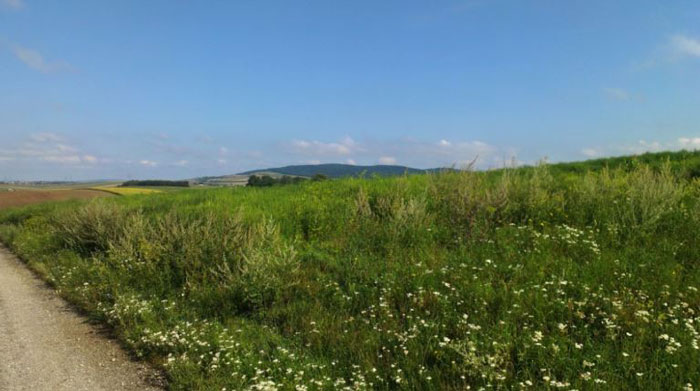
Figure 3. Ragweed growing wild in Austria
[Source: Dr. Epstein]
The researchers tested their hypothesis with six samples of ragweed pollen grown in different conditions. Four of the samples were cultivated in the U.S. and two of the samples were harvested wild in Austria. The six pollen samples and their characteristics are summarized in Table 1 and Figure 4.
Table 1. Six ragweed samples and their characteristics
| Type |
Location Grown |
Year |
Environmental characteristics |
| AG1 |
Jasper County, Missouri, USA |
2011 |
Cultivated in drought conditions with high heat |
| AG2 |
Barton County, Missouri, USA |
2012 |
Grown in wild field after cultivated wheat had been harvested |
| VA1 |
Bruckneudorf, Austria |
2007 |
Wild plants in a meadow without any human influence |
| VA2 |
Vienna, Austria |
2012 |
Wild plants grown on side of highway that were regularly mowed and experienced high levels of highway pollution |
| ALK1 |
Mason County, Illinois, USA |
2013 |
Cultivated in wheat and ragweed cropping system with average temperatures and precipitation |
| ALK2 |
Mason County, Illinois, USA |
2013 |
Cultivated in wheat and ragweed cropping system with extreme drought conditions and little precipitation |
[Source: Table adapted from
Liu et al, 2022,
Supplementary Table 1]
Dr. Epstein and her team collaborated with a botanist colleague to collect wild samples of ragweed in Austria.
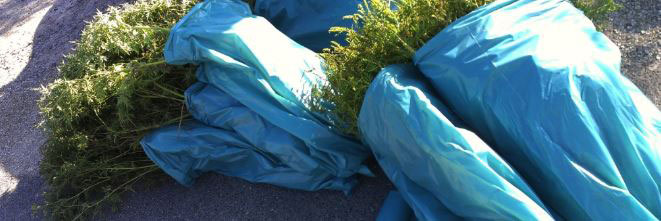
Figure 4. Ragweed harvested with roots and wrapped in plastic for transport.
[Source: Dr. Epstein]
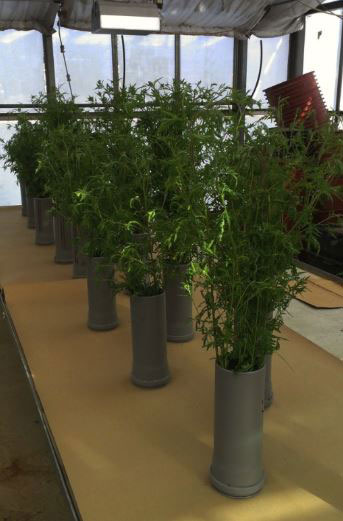
Figure 5. Ragweed plants separated by population and stored in a greenhouse. Vases are placed on clean paper to collect pollen that has dropped.
[Source: Dr. Epstein]
The results showed that AG1, AG2, VA2, and ALK2 caused extensive respiratory inflammation in the mouse models, while ALK1 and VA1 caused significantly less inflammation. “The results confirmed our hypothesis that ragweed grown in different conditions can have different allergenic impacts,” explained Dr. Epstein.
To better understand the pollen samples, the researchers examined the physical and chemical structure of each type of ragweed pollen. They used an electron microscope to visualize the structure and did not find any significant differences.
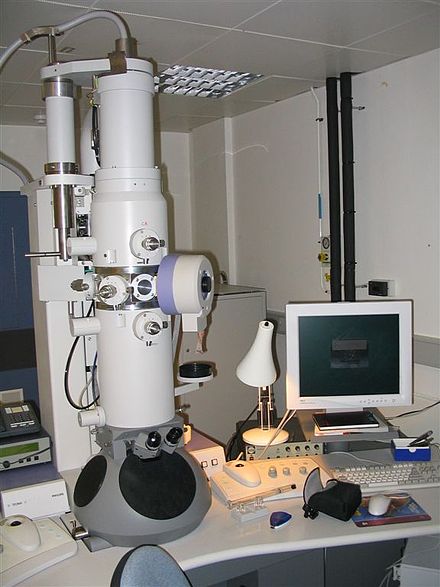
Figure 6. Electron microscope.
[Source: https://en.wikipedia.org/wiki/Electron_microscope#/media/File:Electron_Microscope.jpg]
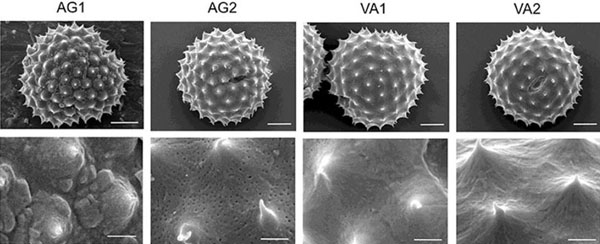
Figure 7. Pollen spores as seen under the electron microscope, magnified 5,000 times (above) and 21,600 times (below).
[Source: Liu et al, 2022, Fig 1c]
The researchers also tested the levels of the allergen Amb a 1, the most common allergen found within ragweed pollen. The ragweed samples from Vienna (VA1 and VA2) had the lowest levels of Amb a 1 in addition to ALK1. However, no correlation was observed between Amb a 1 levels and the severity of allergic response.
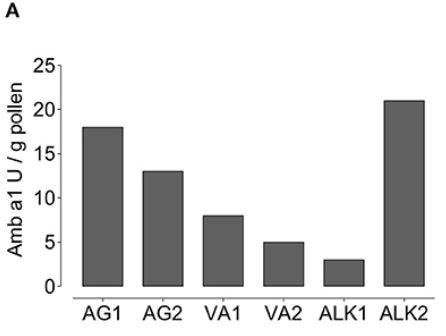
Figure 8. Amount of Amb a 1 allergen per gram of pollen differs among six pollen samples.
[Source: Liu et al, 2022, Fig 1A]
In future research, Dr. Epstein and colleagues plan to look more closely at the structure of the different types of pollen to better understand how environmental conditions affect the severity of ragweed-induced allergic response. In addition, the Atopica research project made Dr. Epstein interested in doing further research on how environmental factors affect human health. Her most recent research project is called Imptox, which looks at the potential health consequences of micro- and nanoplastic particles.
Dr. Michelle Epstein is a Doctor of Allergy and Clinical Immunology in the Department of Dermatology, Experimental Allergy Laboratory at the Medical University of Vienna in Vienna, Austria. Her research interests include allergic asthma and allergic diseases and how they are affected by environmental factors such as climate change, nanoplastics, and genetically modified organisms. When not in the laboratory, Dr. Epstein enjoys hiking, traveling, and writing for a local newspaper.
For More Information:
- Liu, S. et al. 2022. “Influence of the environment on ragweed pollen and their sensitizing capacity in a mouse model of allergic lung inflammation.” Frontiers in Allergy. https://www.frontiersin.org/articles/10.3389/falgy.2022.854038/full
To Learn More:
- Atopica Project. https://atopica.eu/
- Imptox Project. https://www.imptox.eu/en/
- American Academy of Allergy, Asthma, and Immunology. https://www.aaaai.org/tools-for-the-public/conditions-library/allergies/does-climate-change-impact-allergic-disease
- U.S. Environmental Protection Agency. https://www.epa.gov/climate-indicators/climate-change-indicators-ragweed-pollen-season
- Allergy and Asthma Network. https://allergyasthmanetwork.org/allergies/pollen-allergy/ragweed-allergy/
Written by Rebecca Kranz with Andrea Gwosdow, PhD at www.gwosdow.com
HOME | ABOUT | ARCHIVES | TEACHERS | LINKS | CONTACT
All content on this site is © Massachusetts
Society for Medical Research or others. Please read our copyright
statement — it is important. |

